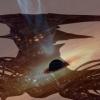All Activity
- Past hour
-

Alien life may not be carbon-based, new study suggests
Moontanman replied to Vmedvil's topic in Popular Science and News
Silicon is not energetically favored as a base for life, the entire universe would at least appear to favor carbon in several ways but complex carbon compounds being formed in interstellar space in clouds that mass many times the Earth is highly indicative that carbon is special. There are other possibilities than silicon to replace carbon, organometallic chemistry seems to indicate some interesting possibilities at molten lava temps but we have no evidence of such chemicals occurring naturally. Boron is, if anything, capable of complex chemistry as interesting as carbon but boron is exceedingly rare in the universe. This guy is highly speculative but it gives you some idea of extreme possibilities. https://www.daviddarling.info/encyclopedia/A/alternative_forms_of_life.html#google_vignette - Today
-

The 10 Worst Mental Health Treatments in History
MikaEmber replied to Vmedvil5's topic in Medical and Health Science
And mental health, whew, it's a journey for sure. I've had my fair share of ups and downs, and during the tough times, reaching out has been a game-changer. You mentioned the mental health hotline, and I couldn't agree more. There's something comforting about knowing there's someone on the other end who gets it, without any judgment. But you know what else has been a lifesaver for me? AA meetings. For anyone out there who might be struggling, you're not alone. There are resources like AA meetings https://nationalrehabhotline.org/ and hotlines ready to lend a listening ear. If you're new here like me, let's navigate this journey together, one step at a time. -

Alien life may not be carbon-based, new study suggests
oldpaddoboy replied to Vmedvil's topic in Popular Science and News
Reminds me of an old Star Trek episode, when they discover a silicon based life form on some planet. My view is that life as we know it, is difficult enough with the right conditions to form, and even longer for complicated so called intelligence beings like us to evolve. How much harder could it be with a Silicon based lifeform. Still, as I like pointing out, in a "near infinite" universe, with near infinite numbers of stars and planets, and with the stuff of life being everywhere we look, those chances are greatly magnified. -
It seems scientists have made chemosensors immobilized on silica nanoparticles for targeted detection of Nickel II Ions, read more at Tailored isatin-derived chemosensor immobilized on silica nanoparticles for targeted detection of Ni(II) ion - ScienceDirect What industrial applications can you think of for these silica nanoparticles with chemosensors?
-
It seems the James Webb Telescope has discovered carbon compounds crucial to life in a star system 1,000 light years away from earth, read more at James Webb telescope discovers carbon compounds crucial to life in star system 1,000 light-years from Earth | Live Science Do you think we will find other life in the universe besides on Earth and if so by what date?
-
-
-
organicco changed their profile photo
- Yesterday
-
stevek110198 joined the community
-
-
-
 Vmedvil reacted to a post in a topic:
Does this Method of Communication go Faster than Light?
Vmedvil reacted to a post in a topic:
Does this Method of Communication go Faster than Light?
-

Does this Method of Communication go Faster than Light?
Vmedvil replied to Talanum46's topic in Silly Claims Forum
No, it would not, and this is not detailed enough to even be considered as such a device. -
I would add it to my temporal lobes to increase my memory abilities. "They are most commonly associated with processing auditory information and with the encoding of memory. The temporal lobes are also believed to play an important role in processing affect/emotions, language, and certain aspects of visual perception."
-
-
This is interesting, I would like a more detailed write up on it from you with all the fine details described.
- Last week
-
Very nice theory
-
Reddob joined the community
-
Nice!
-
Ynim13 joined the community
-
This is an informational piece about how MIT is redefining quantum computing with new entanglement controls, read more at How MIT Is Redefining Quantum Computing With New Entanglement Control (scitechdaily.com) How do you think these new entanglement control systems will change quantum computers, and do you think they will be an improvement?
-
It seems an experimental gene therapy seems to alleviate skeletal defects tied to rare inherited disease according to a study, read more at Experimental gene therapy seems to alleviate symptoms tied to rare disease (statnews.com) Do you think if you had this rare skeletal defect, you would get this gene therapy if you could afford it?
-
-
https://phys.org/news/2024-04-advance-gravitational-collisions-neutron-stars.html APRIL 26, 2024 Editors' notes "Researchers advance detection of gravitational waves to study collisions of neutron stars and black holes" article at link. the paper: https://www.pnas.org/doi/10.1073/pnas.2316474121 Abstract "Multimessenger searches for binary neutron star (BNS) and neutron star-black hole (NSBH) mergers are currently one of the most exciting areas of astronomy. The search for joint electromagnetic and neutrino counterparts to gravitational wave (GW)s has resumed with ALIGO’s, AdVirgo’s and KAGRA’s fourth observing run (O4). To support this effort, public semiautomated data products are sent in near real-time and include localization and source properties to guide complementary observations. In preparation for O4, we have conducted a study using a simulated population of compact binaries and a mock data challenge (MDC) in the form of a real-time replay to optimize and profile the software infrastructure and scientific deliverables. End-toend performance was tested, including data ingestion, running online search pipelines, performing annotations, and issuing alerts to the astrophysics community. We present an overview of the low-latency infrastructure and the performance of the data products that are now being released during O4 based on the MDC. We report the expected median latency for the preliminary alert of full bandwidth searches (29.5 s) and show consistency and accuracy of released data products using the MDC. We report the expected median latency for triggers from early warning searches (−3.1 s), which are new in O4 and target neutron star mergers during inspiral phase. This paper provides a performance overview for LIGO-Virgo-KAGRA (LVK) low-latency alert infrastructure and data products using theMDCand serves as a useful reference for the interpretation of O4 detections." fGet full access to th
-
The JWST doing its job again. Evidence for a Neutron star at the core of Supernova 1987A. Supernova 1987A was, as the name suggests, seen in 1987, and the first supernova ever seen at least in modern times. The following article describes that event and discovery... https://www.livescience.com/space/cosmology/finally-we-have-the-evidence-james-webb-telescope-spots-neutron-star-hiding-in-wreckage-of-famous-1987-supernova "'Finally, we have the evidence': James Webb telescope spots neutron star hiding in wreckage of famous 1987 supernova A neutron star spotted by the James Webb Space Telescope stayed hidden for 37 years while lurking in the wreckage of a stellar explosion, Supernova 1987A. The NASA/ESA/CSA James Webb Space Telescope has observed the best evidence yet for emission from a neutron star at the site of a well-known and recently-observed supernova. The supernova, known as SN 1987A, occurred 160,000 light-years from Earth in the Large Magellanic Cloud. (Image credit: NASA, ESA, CSA, and C. Fransson (Stockholm University), M. Matsuura (Cardiff University), M. J. Barlow (University College London), P. J. Kavanagh (Maynooth University), J. Larsson (KTH Royal Institute of Technology)) "Using the James Webb Space Telescope (JWST), astronomers have ended a nearly decade-long game of celestial hide-and-seek after they discovered a neutron star in the wreckage of a stellar explosion. Supernova 1987A represents the remains of an exploded star that once had a mass around 8 to 10 times that of the sun. It is located around 170,000 light-years away in the Large Magellanic Cloud, a dwarf galaxy neighbor of the Milky Way. Supernova 1987A was first spotted by astronomers 37 years ago in 1987, hence the numerical aspect of its name. As it exploded, Supernova 1987A first showered Earth with ghostly particles called neutrinos and then became visible in bright light. This made it the nearest and brightest supernova seen in the night sky over Earth for around 400 years." extract: "Neutron stars are supported against complete collapse, however, by quantum effects occurring between neutrons in their interiors. These effects prevent the neutrons from cramming together. This so-called "neutron degeneracy pressure" can be overcome if a stellar core has enough mass — or if a neutron star, after its creation, piles on more mass. This would result in the birth of a black hole (if the mass minimum isn't reached, though, it won't happen.)" Showing its worth again, the JWST continues to refine time lines of the universe, along with incredible revelations such as described in the above article. Full article at link.
-
 Moontanman reacted to a post in a topic:
Penrose Diagrams are Misleading.
Moontanman reacted to a post in a topic:
Penrose Diagrams are Misleading.
-

Does this Method of Communication go Faster than Light?
Moontanman replied to Talanum46's topic in Silly Claims Forum
What method? You have not described a method. Moving this to silly claims.


